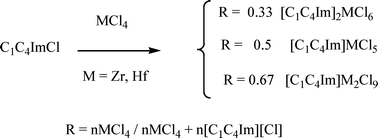Synthesis and characterisation of ionic liquids based on 1-butyl-3-methylimidazolium chloride and MCl4, M = Hf and Zr†
Abstract
Dialkylimidazolium chlorometallate molten salts resulting from the combination of

Maintenance work is planned for Wednesday 1st May 2024 from 9:00am to 11:00am (BST).
During this time, the performance of our website may be affected - searches may run slowly and some pages may be temporarily unavailable. If this happens, please try refreshing your web browser or try waiting two to three minutes before trying again.
We apologise for any inconvenience this might cause and thank you for your patience.
* Corresponding authors
a
Université de Lyon, Institut de Chimie de Lyon, UMR 5265 CNRS-Université de Lyon-ESCPE Lyon, LC2P2, Equipe COMS, ESCPE 43 Boulevard du 11 Novembre 1918, Villeurbanne, France
E-mail:
santini@cpe.fr
Fax: +33(0)472431795
Tel: +33(0)472431794
b Centre Commun de Spectrométrie de Masse, Université de Lyon, ESCPE, 43 Boulevard du 11 Novembre 1918, F-69616 Villeurbanne, France
c Centre Commun de RMN, Université de Lyon, ESCPE, 43 Boulevard du 11 Novembre 1918, F-69616 Villeurbanne, France
d Chemical Metallurgy Group, Faculty of Chemistry, Wrocław University of Technology, Wybreze Wyspianskiego 27, Wrocław, Poland
e Ecole Polytechnique, CNRS UMR 6595 Technopole de Chateau-Gombert 5 Rue Enrico Fermi, Marseille cedex 13, France
f Université d'Orléans CEMHTI - CNRS UPR 3079, Orléans, France
g Université Paris 06, UMR 7196, PECSA Paris, France
Dialkylimidazolium chlorometallate molten salts resulting from the combination of

 Please wait while we load your content...
Something went wrong. Try again?
Please wait while we load your content...
Something went wrong. Try again?
P. S. Campbell, C. C. Santini, D. Bouchu, B. Fenet, L. Rycerz, Y. Chauvin, M. Gaune-Escard, C. Bessada and A. Rollet, Dalton Trans., 2010, 39, 1379 DOI: 10.1039/B919094E
To request permission to reproduce material from this article, please go to the Copyright Clearance Center request page.
If you are an author contributing to an RSC publication, you do not need to request permission provided correct acknowledgement is given.
If you are the author of this article, you do not need to request permission to reproduce figures and diagrams provided correct acknowledgement is given. If you want to reproduce the whole article in a third-party publication (excluding your thesis/dissertation for which permission is not required) please go to the Copyright Clearance Center request page.
Read more about how to correctly acknowledge RSC content.
 Fetching data from CrossRef.
Fetching data from CrossRef.
This may take some time to load.
Loading related content
